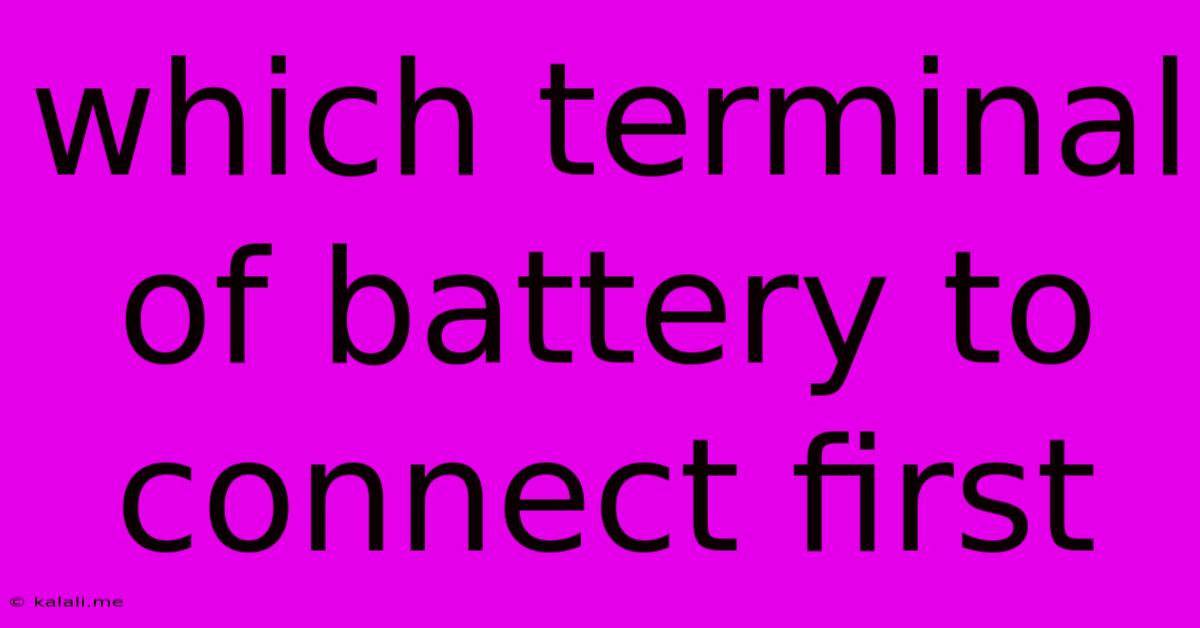Which Terminal Of Battery To Connect First
Kalali
May 19, 2025 · 3 min read

Table of Contents
Which Battery Terminal to Connect First: Avoiding Sparks and Ensuring Safety
Connecting a battery incorrectly can lead to sparks, damage to your electrical system, and even personal injury. Knowing which terminal to connect first is crucial for safety and preventing costly mistakes. This guide clarifies the correct procedure and explains why it's so important. This is essential information for anyone working with car batteries, motorcycle batteries, or other similar power sources.
Understanding the Importance of Connection Order
The correct procedure is always to connect the positive (+) terminal last and disconnect it first. This seemingly simple step significantly reduces the risk of short circuits and accidental sparks. Why? Because connecting the positive terminal before the negative creates a path for current to flow through unintended routes.
The Correct Procedure: Positive Last, Negative First
Here's the step-by-step procedure for safely connecting a battery:
-
Prepare the Battery and Connections: Ensure your battery terminals are clean and free of corrosion. Use a wire brush or terminal cleaner if necessary. Have your cables ready and inspect them for any damage.
-
Connect the Negative (-) Terminal First: Attach the negative (-) cable clamp to the negative (-) terminal of the battery.
-
Connect the Positive (+) Terminal: Attach the positive (+) cable clamp to the positive (+) terminal of the battery.
-
Disconnecting the Battery: Reverse the process for disconnecting. Disconnect the positive (+) terminal first, followed by the negative (-) terminal.
Why This Order Matters: Preventing Short Circuits
Connecting the positive terminal first can create a dangerous situation. If the positive clamp accidentally touches a grounded metal surface (like the chassis of your car), it can create a short circuit. This short circuit can result in:
- Sparks: A potentially dangerous arc that can ignite flammable materials.
- Damage to Electrical Components: The high current surge can fry sensitive electronics in your vehicle.
- Battery Damage: The short circuit can severely damage the battery itself.
- Personal Injury: Sparks and the heat generated can cause burns or other injuries.
Beyond Car Batteries: Applying the Principle to Other Systems
While this article focuses on car batteries, the principle of connecting the positive terminal last and disconnecting it first applies to any system involving a battery or power source. This includes:
- Motorcycle Batteries: The same safety precautions apply.
- Boat Batteries: Especially important in a marine environment due to potential moisture and flammability issues.
- Power Tools with Batteries: Although the risks might be lower, the same connection order should be followed.
Maintaining Battery Health: Cleaning and Care
Regular cleaning of your battery terminals can extend their lifespan and reduce the risk of connection problems. This includes removing corrosion and ensuring a clean, secure connection for your cables.
Conclusion: Prioritize Safety
Following the simple procedure of connecting the negative terminal first and the positive terminal last is crucial for safety and avoiding potential damage. Always prioritize safety when working with batteries and remember to disconnect the positive terminal first. By following these guidelines, you can ensure a safer and more efficient experience every time you work with a battery.
Latest Posts
Latest Posts
-
Gold Is Good Conductor Of Electricity
May 20, 2025
-
Substitute For Crushed Red Pepper Flakes
May 20, 2025
-
Using Work Phone As Personal Phone
May 20, 2025
-
Train From El Prat To Sitges
May 20, 2025
-
Is Toothpaste A Liquid Or A Solid
May 20, 2025
Related Post
Thank you for visiting our website which covers about Which Terminal Of Battery To Connect First . We hope the information provided has been useful to you. Feel free to contact us if you have any questions or need further assistance. See you next time and don't miss to bookmark.